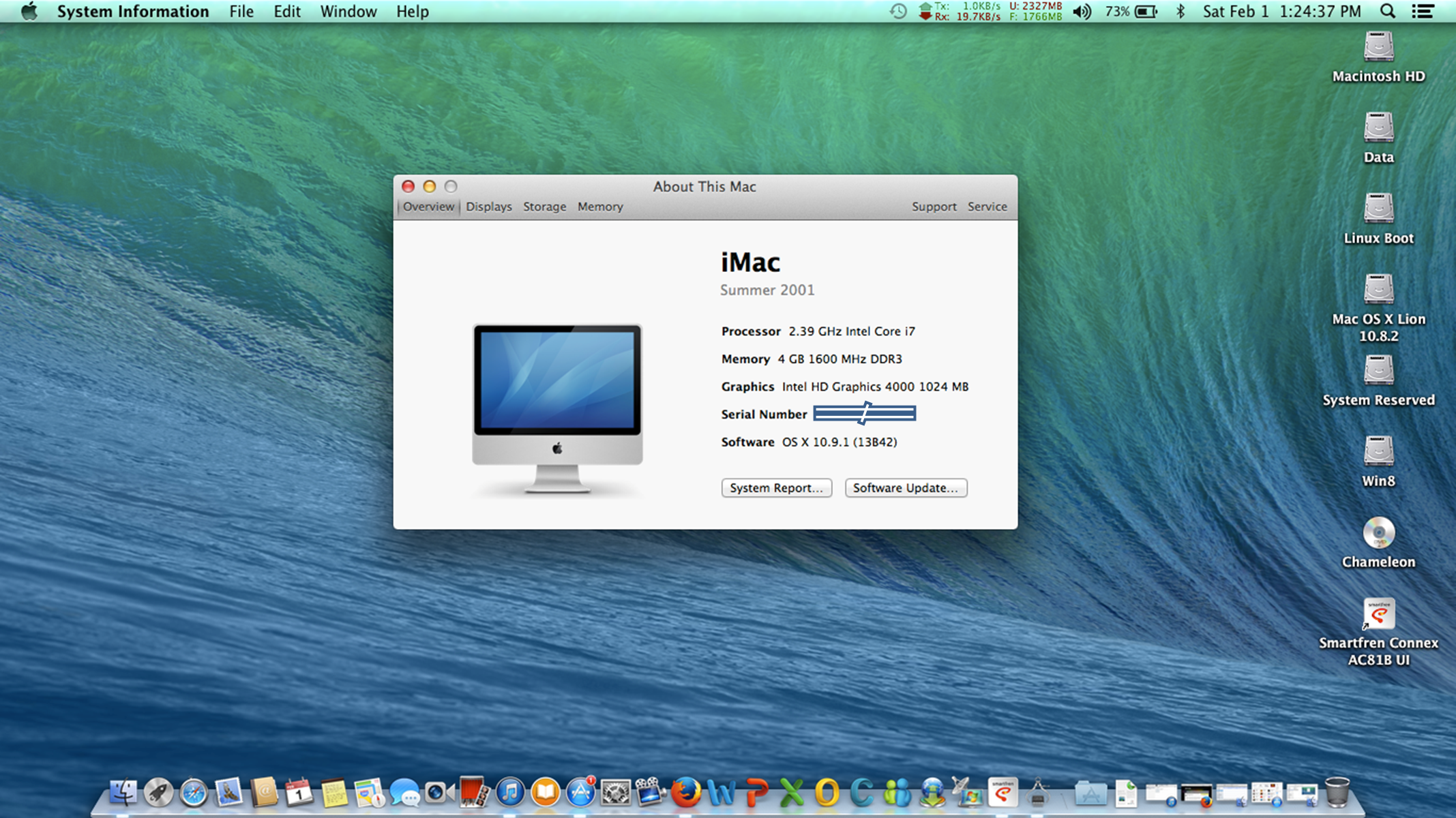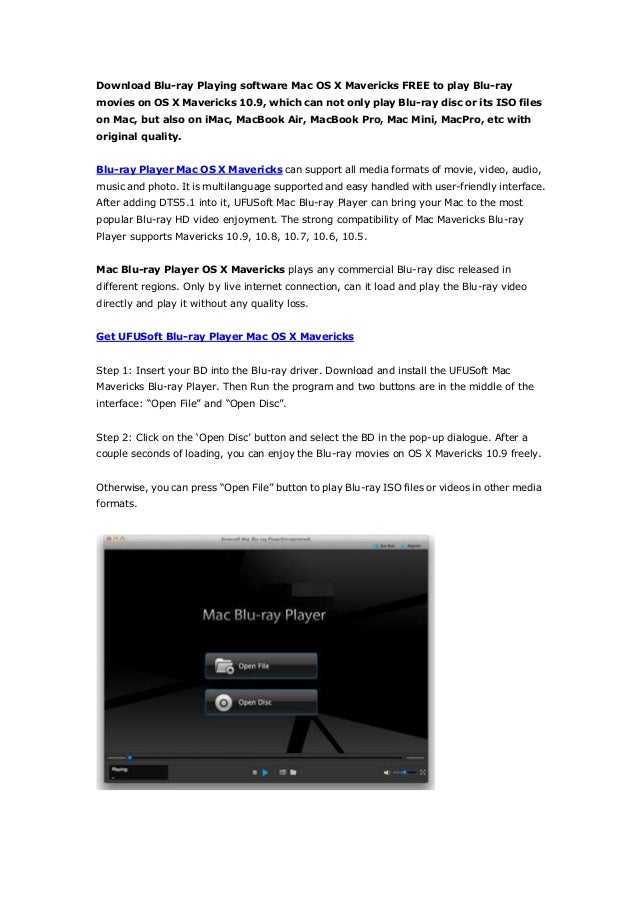Apple has released OS X 10.9 Mavericks, and somewhat surprisingly it is a free upgrade for all existing OS X users. If you’re using a Mac laptop or desktop from the last five years or so, you should be able to download OS X Mavericks for free just by visiting the Mac App Store. Some exclusions and caveats do apply, though, so read on for more information.
OS X Mavericks (version 10.9) is the tenth major release of macOS, Apple Inc. 's desktop and server operating system for Macintosh computers. OS X Mavericks was announced on June 10, 2013, at WWDC 2013, and was released on October 22, 2013 worldwide. MacOS X 10.9 Mavericks VMWare Image. For the curious: This VM can be successfully converted to Parallels 16 by opening the file 'OS X Mavericks.vmx' in Parallels.Just make sure you give it enough CPU, RAM, and GPU specs for it to boot. Apple: Is $HOME/.MacOSX/environment.plist still used in OS X 10.9.2 for setting global environment variables?Helpful? Please support me on Patreon: https://. Clean Install – Mac OS X 10.9 Mavericks. GitHub Gist: instantly share code, notes, and snippets.
Visit this Apple Support page to learn more about upgrading your Mac. Note: If you have Mac OS X 10.7 (Lion) or 10.6 (Snow Leopard), you will need to download OS X El Capitan before you can upgrade to the latest Mac OS. While insecure versions of Firefox will continue to work on OS X 10.8 and earlier, using an up-to-date version of Firefox on a.
Downloading and installing OS X 10.9 Mavericks for free

Before you upgrade to OS X 10.9 for free, the most important question is whether your Mac hardware is compatible. In general, if you’re already running OS X 10.6 Snow Leopard, you should be able to install Mavericks. Here’s a complete list of Mac laptops and desktops compatible with OS X 10.9 Mavericks:
- MacBook Pro (mid/late 2007 and newer)
- MacBook Air (late 2008 and newer)
- iMac (mid 2007 and newer)
- MacBook (late 2008 aluminium, or early 2009 and newer)
- Mac Mini (early 2009 and newer)
- Mac Pro (early 2008 and newer)
- Xserve (early 2009)

Before you begin the upgrade process, you should save and close any open programs. If you’re upgrading some older Mac hardware, you might also find it useful to clear up your hard drive first, by uninstalling unused apps, transferring large files to external storage, and using a clean-up tool such as CCleaner.
If you have Snow Leopard, Lion, or Mountain Lion installed (10.6, 10.7, 10.8), upgrading to 10.9 Mavericks is as simple as heading to the Mac App Store, clicking the huge OS X Mavericks banner, and clicking “Install.” It will download the update (which is around 5GB), and then ask whether you want to begin the installation process. Once you begin the installation, that’s it: It’s a one-step installer without any “next” buttons.
For me, on a fairly bogged-down 2011 MacBook Pro, the free upgrade to OS X Mavericks took around 90 minutes. On a newer and fresher systems, it should be a lot faster.
After installing OS X Mavericks…
Os 10.95
Once the installation process is complete, a notification will pop up offering to teach you about Mavericks’ new features. You should probably click it, especially if you’re coming from Snow Leopard or Lion as quite a lot has changed. The most exciting new features in Mavericks are probably the iCloud Keychain, Notifications tweaks, and some cool low-level tech that should improve battery life and performance (Timer Coalescing, App Nap, and Memory Compression). If you’ve always wished for iBooks, Maps, and Calendar to make the leap from iOS to your Mac, you’re in luck, too.

If you have any problems upgrading, or you want to draw our attention to an interesting new feature (or bug), leave a comment.

Os 10.9 Mavericks
Now read: Is the core of Apple’s OS X rotting from within?
If you are on a Windows computer, see Install an older version of Adobe Reader | Windows.
Installing Adobe Reader is a two-step process. First you download the installation package, and then you install Adobe Reader from that package file.
Before you install, make sure that your system meets the minimum system requirements.
Note:
If you're running Mac OS X 10.9 or later, install the latest version of Reader. For step-by-step instructions, see Install Adobe Acrobat Reader DC on Mac OS.
Select your operating system, a language, and the version of Reader that you want to install. Then click Download now.
When asked whether to open or save the .dmg file, select Save File, and then click OK.
Important: If you do not see this dialog box, another window could be blocking it. Try moving any other windows out of the way.
Double-click the .dmg file. If you don't see the Downloads window, choose Tools > Downloads.
If the download package doesn't appear in the Downloads window and a Thank You screen remains visible, click the download link on the Thank You screen.
Double-click the Adobe Reader [version] Installer.pkg to start the installation.
If a dialog box appears telling you to quit Reader, close Reader, and then click OK.
When the Install Adobe Reader dialog box appears, click Continue. Follow the onscreen instructions to install Reader.
Note:
If you're running Mac OS X 10.9 or later, install the latest version of Reader. For step-by-step instructions, see Install Adobe Acrobat Reader DC on Mac OS.
Select your operating system, a language, and the version of Reader that you want to install. Then click Download now.
If a dialog box appears telling you to quit Reader, close Reader, and then click OK.
When the Install Adobe Reader [version] dialog box appears, click Continue. Follow the onscreen instructions to install Reader.
When the Install Succeeded window appears, click Close.
To see if other users are experiencing similar download and installation problems, visit the Acrobat Reader forum, or the Deployment & Installation forum on AcrobatUsers.com. Try posting your problem on the forums for interactive troubleshooting. When posting on forums, include your operating system and product version number.
More like this

Comments are closed.